Exploring the Birthstone for November 29: Significance and More
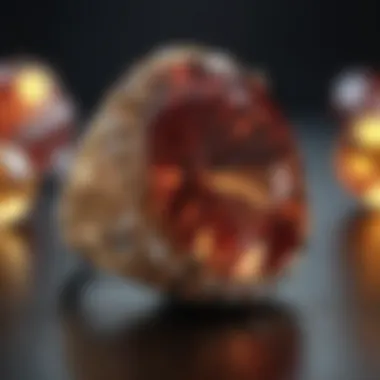
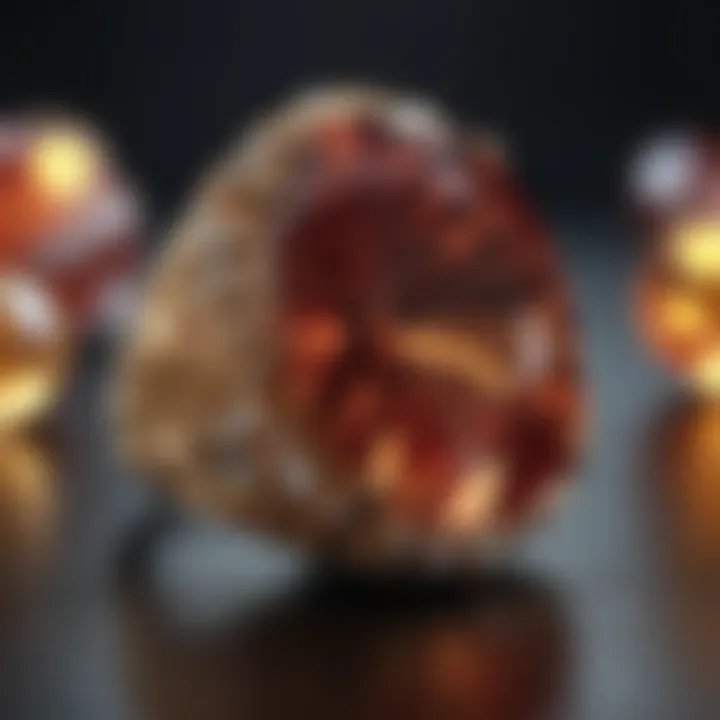
Intro
November 29 is associated with a distinctive birthstone that holds both historical charm and cultural significance. This article will lead you through an exploration of the birthstone's origins, its unique properties, and the various meanings it holds. You will gain insight into how this gemstone influences the identity and expressions of those born on this day.
Gemstone Overview
Definition and Characteristics
The birthstone for November 29 is topaz. This gemstone is recognized for its stunning hues, ranging from clear to blue, yellow, and even orange. Topaz is a silicate mineral composed of aluminum and fluorine along with other elements, giving it a robust and adaptable nature that appeals to collectors and jewelry designers alike. Its clarity can achieve a glass-like finish, often leading to its classification as a precious gemstone.
Classification of Gemstones
Topaz falls into the category of silicate minerals, which are characterized by the presence of silicon and oxygen. In terms of classification, gemstones are typically divided into three groups: precious, semi-precious, and organic. Topaz is regarded as a precious gemstone due to its beauty and durability, along with cultural perceptions that imbue it with significance.
Properties of Gemstones
Physical Properties
Topaz is renowned for its excellent hardness, rated 8 on the Mohs scale. This quality makes it resistant to scratching, enhancing its viability as a gemstone in jewelry. In terms of light behavior, topaz exhibits a distinct brilliance and clarity due to its refractive index. Its cleavage, which refers to how it breaks, can affect how it is cut and shaped, thus impacting its overall appearance.
Chemical Properties
Chemically, topaz is primarily composed of aluminum, silicon, fluorine, and oxygen. The presence of trace elements can lead to variations in color, making it one of the most versatile gemstones. The structure of topaz allows for a range of color treatments, enhancing its aesthetic appeal. Variants such as imperial topaz are especially valued, showcasing shades of pink and orange.
"Topaz has been revered throughout history, not just for its beauty, but also for its perceived healing properties and significance in various cultures."
End
This exploration of the birthstone for November 29 illuminates the inherent value of topaz. By understanding its origins, properties, and cultural meanings, one can appreciate how this gemstone contributes to personal identity and expression.
Intro
The topic of birthstones carries significant weight in both cultural and personal contexts. In this article, we will explore the birthstone associated with November 29, specifically focusing on the properties and meanings of this gemstone. Birthstones offer individuals a connection to their identity, providing not only aesthetic value but also deep-rooted symbolic meanings. By understanding your birthstone, you gain insight into its historical significance and what it can represent about you or your personality.
Investing time in knowledge about birthstones can guide you in making informed decisions if you choose to incorporate these precious gems into your life or jewelry collection. Furthermore, they can serve as meaningful gifts that carry emotional weight, establishing connections beyond mere physical beauty. Thus, understanding the birthstone for November is essential for enthusiasts, collectors, and individuals seeking to expand their knowledge about gemstones in general.
Understanding Birthstones
Birthstones have held a place of importance in various cultures throughout history. Each month corresponds to its own unique gem, believed to hold special power or significance for those born in that month. This practice dates back to ancient civilizations, like the Babylonians, who first associated gemstones with the months of the year in the 6th century BC.
In modern times, birthstones have evolved into more than just symbols of birth. They often represent personality traits, emotional bonds, and spiritual guidance. Many people choose to wear jewelry featuring their birthstone as a means to manifest qualities associated with the stone. Moreover, understanding the characteristics of a birthstone can deepen one's appreciation for its rarity and value.
Benefits of Birthstones:
- Personal Connection: Wearing or gifting birthstones often fosters a sense of identity.
- Emotional Resonance: Different stones are tied to various emotional benefits or healing properties.
- Aesthetic Value: Beyond meanings, these stones enhance the beauty of jewelry, making them versatile accessories.
- Gifting Significance: They serve as thoughtful gifts that convey deeper meanings.
As we delve deeper into the specifics of the birthstone for November 29, we will analyze what makes this gem unique, its historical significance, and its role in personal identity.
The Birthstone for November
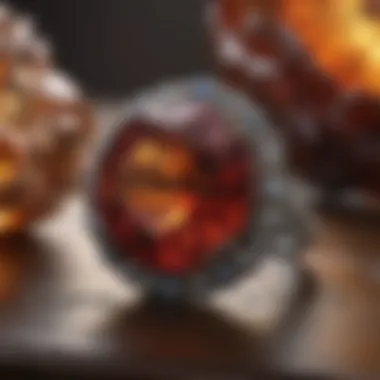
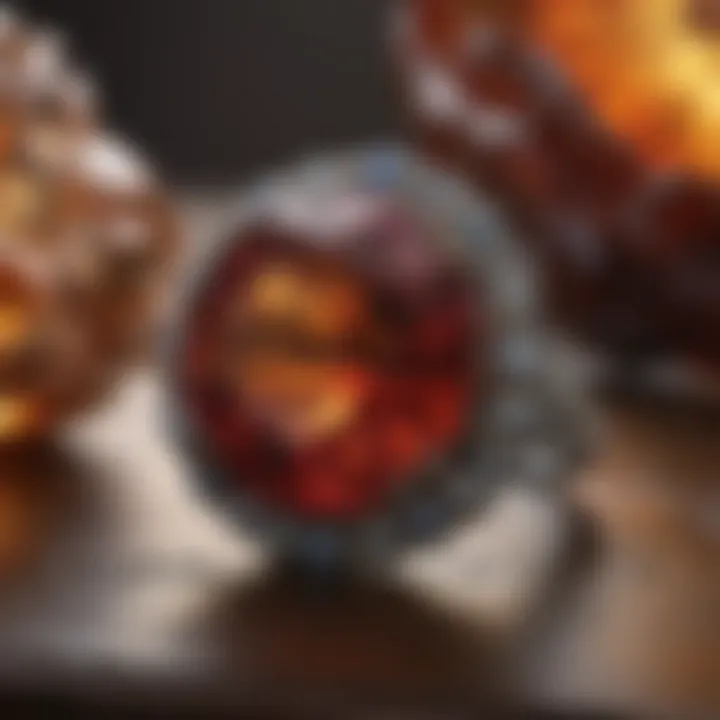
The birthstone for November, specifically for those born on November 29, is Topaz. This gemstone holds significant esteem in both the cultural and metaphysical realms. The importance of Topaz lies in its multifaceted characteristics and its historical context. For individuals born in this month, owning or wearing Topaz is considered a way to harness its reputed benefits.
One critical aspect to understand is the deep-rooted historical significance of Topaz. The gemstone has been a symbol of strength, protection, and good fortune for centuries. It has various associations across different cultures, enhancing its appeal and depth. Furthermore, Topaz serves not only as an ornament but also as a personal talisman. Those who embrace their birthstone often find comfort and identity in this connection. This article will explore Topaz deeply, highlighting its properties, significance, and the alternatives that can complement the choice for November.
Deep Dive into Topaz
Topaz is diverse in appearance and characteristics. It comes in various colors, though the golden yellow variety is often most recognized as the birthstone for November. The mineral itself is a silicate of aluminium and fluorine. Its hardness ranks an impressive 8 on the Mohs scale, making it a durable choice for all types of jewelry.
The congenial nature of Topaz lends itself well to many design styles. When selecting Topaz, one should consider the cut, color intensity, and clarity. The more saturated the color, the more valuable the stone tends to be. Additionally, the transparency of Topaz plays a role in its perceived quality—a clear, clean stone is generally more sought after.
In combination with its aesthetic appeal, Topaz is believed to have therapeutic properties. Many cultures have utilized it for healing purposes, believing it can relieve stress and promote mental clarity. This adds a layer of relevance for those who value both beauty and wellness in their gemstone choices.
Other Alternatives
For those who may not resonate with Topaz, other gemstones can serve as potent alternatives for November birthdays. The most notable alternative is** Citrine**. This stone shares some similarities with Topaz. Citrine is often found in the same warm hues and can also symbolize abundance and prosperity.
Another contender is Smoky Quartz, which brings its unique grounding properties. While not as vivid as Topaz or Citrine, Smoky Quartz has its appeal for those looking for a more understated elegance
- Citrine: Known as the "merchant's stone" for its believed ability to attract wealth.
- Smoky Quartz: Provides grounding energy and is favored in spiritual practices.
Each option brings its set of characteristics and potential benefits. Selecting a gemstone should be a personal choice, one that aligns with individual preferences and needs.
Topaz Characteristics
Topaz is not merely a gemstone; it holds great significance for individuals, especially those born on November 29. Understanding the specific characteristics of topaz provides valuable insight into its appeal and mystique. These characteristics include its color variations and physical properties, both of which are essential in identifying quality topaz and understanding its broader cultural and historical significance.
Color Variations
Topaz manifests in a spectrum of colors, making it a versatile and fascinating stone. The most commonly recognized color is golden yellow, which mimics the warm hue of sunlight. However, topaz also exists in shades of blue, pink, and even colorless forms. This range of colors is produced through natural processes, such as the presence of certain trace elements. For instance, the blue color can result from irradiation, which creates a striking visual effect.
Additionally, there are two popular types of topaz known for their colors. Imperial Topaz showcases a rich orange to pink hue, often highly valued among collectors. In contrast, the tranquil blue topaz is often preferred for its calming appearance, making it a popular choice in jewelry.
Understanding these colors is crucial for gemstone enthusiasts. When purchasing topaz, it is essential to consider not just the appearance but also how the color reflects light, which influences its overall desirability.
Physical Properties
The physical properties of topaz contribute significantly to its status in the gem world. On the Mohs scale of mineral hardness, topaz ranks at an impressive 8. This high rating indicates durability and resistance to scratches, which is a beneficial feature for jewelry pieces that endure daily wear.
In addition to hardness, topaz possesses excellent clarity. Most topaz stones are eye-clean, meaning internal flaws are rarely visible to the naked eye. This clarity enhances its brilliance when cut and polished, allowing it to emit a captivating gleam.
One must also consider the refractive index of topaz, which is an important measure of how well a gemstone bends light. Topaz typically has a refractive index ranging from 1.609 to 1.630, contributing to its ability to reflect light effectively.
Historical Significance of Topaz
Topaz has long been revered not only for its beauty but also for its deeper meanings and connections to various cultures and historical periods. The significance of Topaz in history reflects a rich tapestry of lore, use, and value placed on this stone through centuries. As we examine its historical context, we can glean how Topaz has transcended mere adornment to become a symbol of power, wisdom, and healing.
Cultural References
In many cultures, Topaz is associated with strength and protection. For instance, ancient Egyptians referred to the gemstone as a symbol of the Sun God Ra. They believed that wearing Topaz could ward off evil spirits and ensure safety from harm. The color of Topaz, often a golden hue, was emblematic of the warm rays of the sun.
In medieval Europe, Topaz was considered a talisman against enemies. It was believed that it could prevent anger and promote harmony among its wearers.
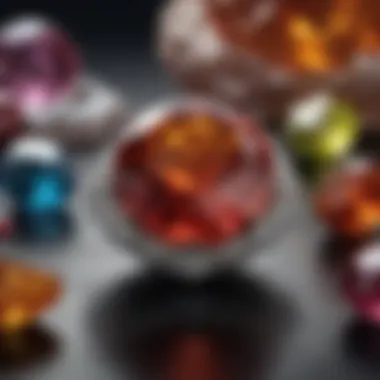
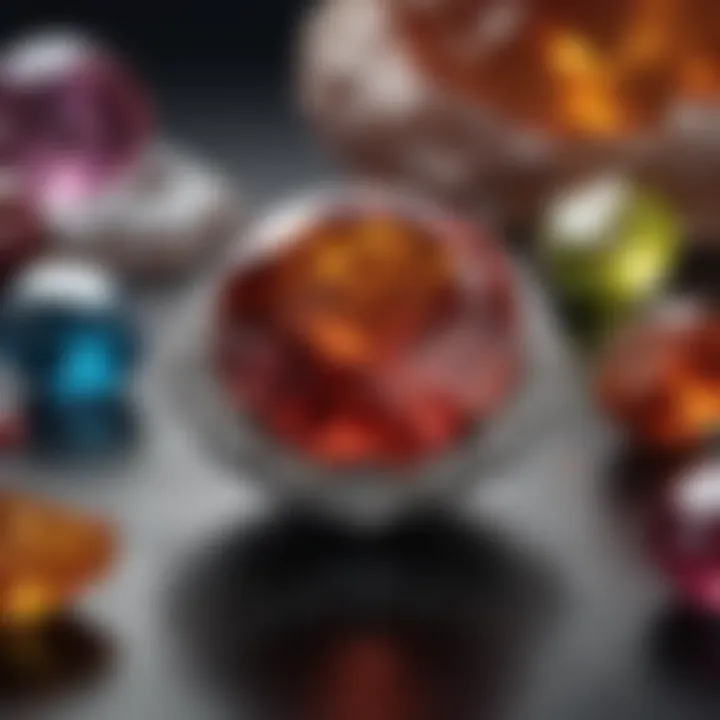
Other cultures have also embraced Topaz in a variety of ways. In Hindu tradition, the gemstone was linked to the concept of enlightenment. It was used in spiritual practices to enhance clarity and focus, helping practitioners on their journey toward self-discovery.
Historical Uses
Historically, Topaz has served several practical functions beyond ornamental use. In ancient times, it was common to engrave or carve inscriptions into the stone. This practice was especially prevalent in Roman culture, where great care was taken to create works of art on the surface of Topaz.
Moreover, in the realm of healing, Topaz was believed to have therapeutic properties. Historically, it was utilized to treat ailments such as fever and asthma, as cultures believed that it could balance the body’s energies. This belief in the metaphysical properties of Topaz demonstrates its importance not just as a stone of beauty but also as a source of healing and comfort for many.
The rich historical significance of Topaz establishes a strong connection between past and present, showing how much this gemstone has influenced various cultures. Both its attributes and the reverence it has received through the ages underscore the gemstone's importance in the world of gemstones.
Identifying Quality Topaz
Identifying quality topaz is essential for those seeking to invest in, collect, or design jewelry that features this stunning gemstone. The crystal's value and appeal can greatly vary based on several important criteria. These criteria include clarity, cut, color, and carat weight. Each element contributes not only to the aesthetic charm of topaz but also to its market value and desirability.
Understanding the quality of topaz can help enthusiasts make informed decisions and avoid common pitfalls. Additionally, knowing how to assess these factors can enhance the overall experience of selecting topaz for personal use or investment.
Buying Guide
When buying topaz, it is crucial to pay attention to several specific aspects.
- Color: Quality topaz generally comes in various shades. A rich, vibrant color often indicates higher value. The most sought-after colors include imperial orange and deep blue. Lighter hues, while still appealing, might not carry the same desirability.
- Clarity: Clarity refers to the presence or absence of internal flaws (inclusions). A higher clarity level usually signifies quality. Look for stones that are transparent and free of visible inclusions.
- Cut: The cut significantly affects how light interacts with the gemstone. A well-cut topaz reflects light beautifully. Various shapes exist, such as oval, round, and princess cut; the right cut enhances the stone's allure.
- Carat Weight: Carat weight impacts the price. Larger stones tend to be rarer and thus more expensive. However, a smaller stone of excellent color and clarity can outperform a larger one of lesser quality.
It's advisable to purchase topaz from reputable jewelers or certified gemologists. This ensures the gemstone has been properly evaluated. Certificates of authenticity are essential.
Common Misconceptions
Many misconceptions exist regarding topaz, potentially confusing buyers. Addressing these misconceptions can prevent misinformation and enhance understanding of this remarkable gemstone.
- Myth 1: All Topaz is Blue: While blue topaz is popular, it is not the only type. Topaz comes in numerous hues, including yellow, pink, and clear varieties. This diversity should not be overlooked.
- Myth 2: Topaz is Fragile: Some people believe that topaz is easily damaged. In reality, topaz has a hardness rating of 8 on the Mohs scale, making it quite durable.
- Myth 3: All Topaz is Treated: While some topaz undergoes treatments to enhance color, not all topaz is treated. Natural vivid colors are available, and they hold significant value.
Understanding these misconceptions can lead to more informed purchases and greater appreciation for topaz in its many forms. By having accurate information, buyers can select topaz with confidence.
Metaphysical Properties of Topaz
Topaz is not only appreciated for its physical beauty but also for its metaphysical attributes. In many cultures, it is associated with a plethora of spiritual benefits and emotional healing properties. Understanding these concepts is crucial for gemstone enthusiasts and collectors. It enriches their appreciation of Topaz, going beyond mere aesthetics to explore its importance in personal growth and emotional well-being.
Spiritual Benefits
Many believe that Topaz brings clarity of thought, enhancing mental focus. This stone is often thought to facilitate deeper connections during meditation. By promoting inner peace, it can assist individuals in attaining a higher spiritual state. Using Topaz during meditation can help practitioners open up channels of communication with their higher self.
Moreover, Topaz is reputed to embody certain protective qualities. It is said to guard against negativity, helping individuals maintain a calm mind in stressful situations. People often wear Topaz as a talisman, believing it shields them from emotional turmoil. In this way, Topaz fosters a sense of security, which can significantly influence one’s spiritual journey.
Emotional Healing
Topaz holds considerable relevance when it comes to emotional healing. Individuals suffering from anxiety and stress might find solace in this stone. It is commonly said to help in mitigating feelings of despondency and promoting joy. Many practitioners suggest that Topaz can facilitate healing by encouraging self-acceptance. This feature encourages individuals to appreciate their true selves without external validation.
In addition, Topaz provides emotional stability during chaotic times. It can support individuals in managing their emotions better, making it a valuable resource for those dealing with relationship challenges. The soothing energy of Topaz is believed to help in mending emotional wounds, making it a cherished ally for anyone focusing on emotional recovery.
In summary, the metaphysical properties of Topaz embody a significant aspect of its worth. From spiritual elevation to emotional stabilization, these facets enhance the overall understanding of this beautiful gemstone.
Topaz is not just a stone; it represents a journey of spiritual and emotional discovery.
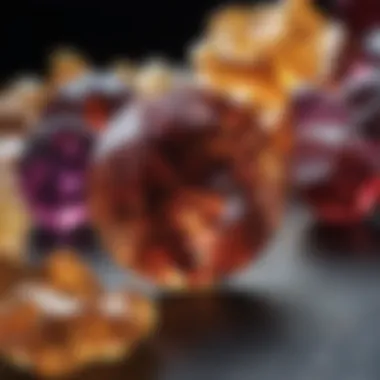

Topaz in Jewelry
Topaz holds a significant place in the world of jewelry, especially for those born in November. Its vibrant colors and robust nature make it a favored choice among jewelers and gemstone lovers alike. The importance of Topaz in jewelry design extends beyond aesthetic appeal; it also carries connotations of strength, clarity, and wisdom. As its popularity grows, understanding the nuances of incorporating Topaz into jewelry becomes essential for both collectors and designers.
Design Considerations
When designing with Topaz, several factors should be considered. First, the stone's wide range of colors offers versatility. From the classic golden hues to the more rare blue, green, and even pink varieties, each shade can convey different moods and messages. For example, blue Topaz is often associated with tranquility, making it suitable for pieces intended as gifts for calming occasions.
- Metal Choice: Topaz pairs well with various metals, including white gold, yellow gold, and sterling silver. The setting should enhance the stone's beauty while ensuring durability.
- Cut: The cut of Topaz significantly influences its brilliance. Shapes like the round brilliant or the emerald cut can maximize light reflection. Selecting the right cut can bring out the depth of color in the stone.
- Style: Whether it’s for a modern or vintage piece, incorporating Topaz requires attention to the overall style. For example, a simple pendant can focus on a single large gemstone, while intricate designs might incorporate smaller stones as accents.
Care and Maintenance
Maintaining the beauty of Topaz jewelry involves some straightforward practices. While Topaz is relatively durable, it is not indestructible. Here are essential care tips:
- Cleaning: Regular cleaning with mild soap and water is recommended. Avoid harsh chemicals that could dull the stone's surface.
- Storage: When not worn, store Topaz jewelry in a soft pouch or separate compartments to prevent scratches from other surfaces.
- Avoid Heat: Excessive heat can cause Topaz to change color. Keep it away from high-temperature environments.
- Regular Checks: Have settings and clasps checked periodically by a professional jeweler to ensure they are secure and functioning properly.
"Proper care ensures that your Topaz jewelry remains a stunning representation of elegance and choice."
In summary, Topaz is not just a beautiful gemstone but a meaningful element in jewelry design. Understanding its properties and care enhances appreciation for this November birthstone, empowering wearers to express their identity through its exquisite forms.
Comparative Analysis with Other November Stones
Analyzing the birthstones associated with November allows us to understand their unique qualities and how they relate to each other. November has two significant stones: Topaz and Citrine. Each holds its own distinct attributes, cultural significance, and potential benefits for individuals born during this month. This comparative analysis serves as an essential exploration in this article, as it illuminates how these gems influence personal identity and aesthetic choice.
Citrine vs. Topaz
Citrine and Topaz, while both celebrated for their warm hues, present different characteristics. Citrine is known for its vibrant yellow to brownish tones. This stone is often called the "merchant's stone" for its reputed ability to attract wealth and prosperity. It is generally less expensive, making it popular among collectors and enthusiasts. The stone also carries a strong emphasis on optimism and manifestation, aiding those on their life journeys.
Topaz, however, is renowned for its remarkable variety of colors, particularly its blue and golden-yellow shades. It is often considered a stone of communication, clarity, and emotional balance. Unlike Citrine, Topaz is believed to impart strength and intelligence and is associated with social prominence. When comparing these two birthstones, it is evident that while they share some overlapping qualities, their energies and intended purposes differ significantly.
In essence, when choosing between Citrine and Topaz, one should consider the desired properties. If the goal is emotional strength and clarity, Topaz might be the preferred choice. For those focused more on abundance and positive energy, Citrine would be more suited.
Impact on Personal Identity
The stones one chooses to wear or adorn can significantly affect their sense of identity. Both Topaz and Citrine can serve as reflections of personality traits or aspirations. For a person who values emotional growth and clarity, Topaz can reinforce these qualities. It is often seen as a means to convey confidence and social connection. Individuals born on November 29th might find Topaz to be not only a symbol of their birth month but also an enhancer of their personal traits.
In contrast, Citrine appeals to those who prioritize success and positivity. Wearing Citrine can instill a strong sense of purpose and motivation. Therefore, the impact of these stones on personal identity is profound. Each stone has the capacity to empower its wearer, aligning with their values, beliefs, and life goals.
Ultimately, understanding these gemstones' differences and their influence on personal identity paves the way for a deeper appreciation. It allows individuals to make more informed choices when selecting the right stone for their needs.
In summary, both Topaz and Citrine significantly impact the self-perception and identity of individuals born in November. Therefore, it is essential to consider the qualities and benefits of each gemstone to choose one that best aligns with one's personal journey.
Culminations and Final Thoughts
The exploration of the birthstone for November 29 leads to insightful realms concerning its significance. The article encapsulates not just the properties and history of Topaz, but also offers perspective on the broader role of birthstones in personal identity. In modern society, birthstones serve as more than mere ornamental choices; they embody individual narratives, emotional connections, and cultural heritage.
The Role of Birthstones Today
In contemporary culture, birthstones like Topaz hold considerable relevance. They are often gifted to commemorate birthdays, celebrations, and significant life events. The personal connection formed with a gemstone can influence one's preferences in jewelry and fashion. Furthermore, it enhances emotional bonds between people, marking special occasions. Birthstones are frequently seen accompanying significant milestones, such as graduations or anniversaries. This tradition continues to evolve as individuals seek unique ways to express themselves through gemstones. Each stone, including Topaz, carries its own story and personal significance.
Birthstones represent not only individual identity but also shared traditions and cultural legacies.
Personal Reflection
Reflecting on one's birthstone can provide depth to self-understanding. For those born on November 29, the properties of Topaz can evoke feelings of empowerment, clarity, and purpose. Many find that wearing their birthstone fosters a sense of grounding and identity, helping them navigate life's challenges. It often prompts deeper exploration of personal attributes and aspirations. This sentiment ties back to the historical significance of birthstones, which have long been believed to bring strength or healing. Understanding one's birthstone can create a reflective bridge to the past, instilling a sense of belonging.
Overall, the inquiry into the birthstone for November 29 reveals a rich tapestry of meanings, elucidating the importance of stones in personal expression and cultural narratives.



